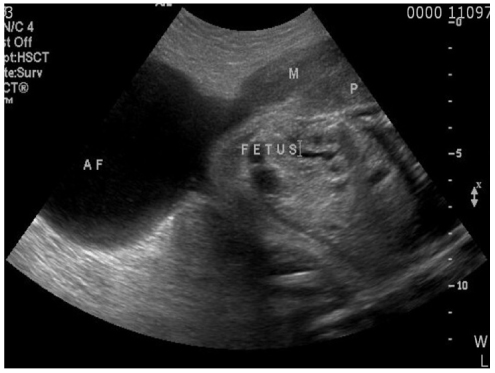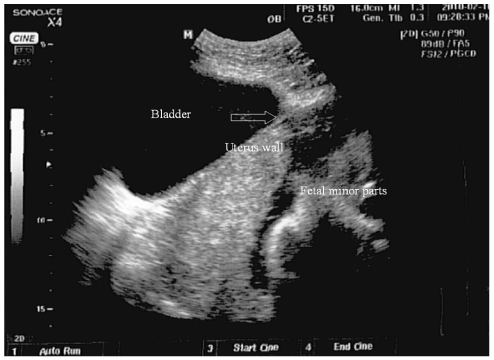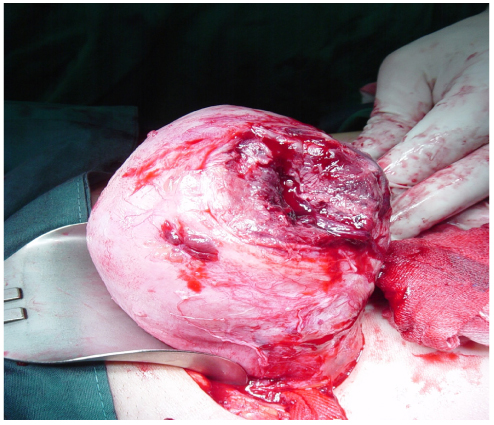Korean J Obstet Gynecol.
2012 Dec;55(12):973-977. 10.5468/KJOG.2012.55.12.973.
Recurrent spontaneous uterine rupture during the third trimester in a woman with history of laparoscopic cornual resection and cervical dysplasia
- Affiliations
-
- 1Department of Obstetrics and Gynecology, CHA Bundang Medical Center, CHA University, Seongnam, Korea. bestob@cha.ac.kr
- KMID: 2274208
- DOI: http://doi.org/10.5468/KJOG.2012.55.12.973
Abstract
- Uterine rupture during the course of pregnancy is an uncommon obstetric event. Rupture of an unscarred uterus is rare, whereas rupture of a scarred uterus is more common and is usually the result of a Cesarean section. Uterine rupture during pregnancy usually occurs in patient with a scarred uterus, and recurrent uterine rupture usually occurs at a prior ruptured site. However, recurrent uterine rupture that occurs at a different site, regardless of prior rupture site, has yet to be reported. The patient described in this case report had cervical dysplasia with positive for human papilloma virus (HPV) type 16. As the presence of a precancerous lesion in the cervix is reported to increase the risk of preterm birth and spontaneous uterine rupture, a possible correlation between recurrent uterine rupture and cervical dysplasia was considered for this patient.
MeSH Terms
Figure
Reference
-
1. Al-Zirqi I, Stray-Pedersen B, Forsén L, Vangen S. Uterine rupture after previous caesarean section. BJOG. 2010. 117:809–820.2. Kaczmarczyk M, Sparén P, Terry P, Cnattingius S. Risk factors for uterine rupture and neonatal consequences of uterine rupture: a population-based study of successive pregnancies in Sweden. BJOG. 2007. 114:1208–1214.3. Turner MJ. Uterine rupture. Best Pract Res Clin Obstet Gynaecol. 2002. 16:69–79.4. Bruinsma FJ, Quinn MA. The risk of preterm birth following treatment for precancerous changes in the cervix: a systematic review and meta-analysis. BJOG. 2011. 118:1031–1041.5. van Alphen M, van Vugt JM, Hummel P, van Geijn HP. Recurrent uterine rupture diagnosed by ultrasound. Ultrasound Obstet Gynecol. 1995. 5:419–421.6. Berghahn L, Christensen D, Droste S. Uterine rupture during second-trimester abortion associated with misoprostol. Obstet Gynecol. 2001. 98:976–977.7. Mishra A, Landzberg BR, Parente JT. Uterine rupture in association with alkaloidal ("crack") cocaine abuse. Am J Obstet Gynecol. 1995. 173:243–244.8. Su CF, Tsai HJ, Chen GD, Shih YT, Lee MS. Uterine rupture at scar of prior laparoscopic cornuostomy after vaginal delivery of a full-term healthy infant. J Obstet Gynaecol Res. 2008. 34:688–691.9. Pelosi MA 3rd, Pelosi MA. Spontaneous uterine rupture at thirty-three weeks subsequent to previous superficial laparoscopic myomectomy. Am J Obstet Gynecol. 1997. 177:1547–1549.10. Hockstein S. Spontaneous uterine rupture in the early third trimester after laparoscopically assisted myomectomy. A case report. J Reprod Med. 2000. 45:139–141.11. Lantinen AJ. Labor following previous cesarean section. Am J Obstet Gynecol. 1980. 137:517.12. Spaulding LB, Gallup DG. Current concepts of management of rupture of the gravid uterus. Obstet Gynecol. 1979. 54:437–441.13. Lee SL, Huang LW, Seow KM, Hwang JL. Spontaneous perforation of a pyometra in a postmenopausal woman with untreated cervical cancer and "forgotten" intrauterine device. Taiwan J Obstet Gynecol. 2007. 46:439–441.14. Chan LY, Yu VS, Ho LC, Lok YH, Hui SK. Spontaneous uterine perforation of pyometra. A report of three cases. J Reprod Med. 2000. 45:857–860.15. Vyas S, Kumar A, Prakash M, Kapoor R, Kumar P, Khandelwal N. Spontaneous perforation of pyometra in a cervical cancer patient: a case report and literature review. Cancer Imaging. 2009. 9:12–14.
- Full Text Links
- Actions
-
Cited
- CITED
-
- Close
- Share
- Similar articles
-
- Repetitive Spontaneous Uterine Rupture in the First Trimester after Laparoscopic Myomectomy: A Case Report and Review of Literature
- Spontaneous Uterine Rupture in the First Trimester: A Case Report
- A Case of Cornual Curettage Under the High-resolution Ultrasound Guidance
- A case of cornual pregnancy ruptured at 24 week's gestation
- A Case of Spontaneous Uterine Rupture in the Second Trimester of Pregnancy




